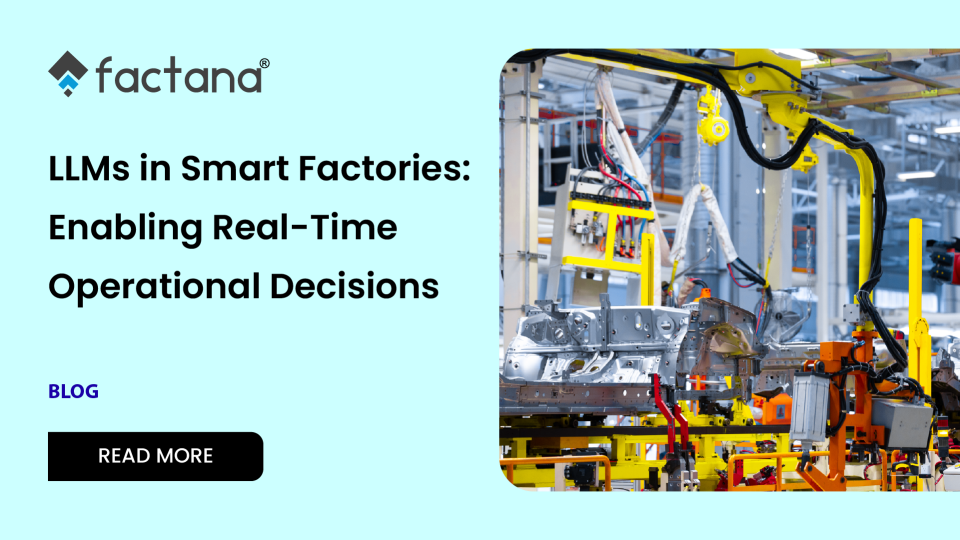Imagine a factory floor where a maintenance technician can diagnose a complex machine issue in seconds, simply by asking a question in plain English. This isn’t a futuristic concept; it’s the power of Large Language Models (LLMs) in smart factories.
As the manufacturing industry undergoes a digital transformation, LLMs are emerging as a powerful class of AI tools, enabling real-time insights, improved automation, and more efficient operations.
But what exactly are LLMs, how do they fit into industrial environments, and what value can they bring to factory operations? This article explores the fundamentals of LLMs and how they support faster, more informed decision-making in modern industrial settings.
What Are LLMs?
Large Language Models are AI systems trained on massive datasets to understand, generate, and respond in human-like language. Examples include OpenAI’s GPT, Google’s PaLM, and Meta’s LLaMA.
Initially designed for chat applications and content generation, these models are now being integrated into manufacturing environments to act as industrial AI assistants, providing instant access to insights, documentation, and analytics using natural language.
What Is a Smart Factory?
A smart factory is a connected, data-driven environment that brings together IoT, robotics, edge computing, and AI. These technologies enable real-time monitoring, predictive maintenance, and process automation.
However, the increasing flow of data across machines, sensors, and software can be difficult to manage and interpret. This is where LLMs for manufacturing proves valuable, helping operations teams understand complex data and make timely decisions.
Why LLMs Matter in Smart Factories
LLMs offer a conversational interface between people, machines, and data systems. They help manufacturing teams:
- Ask questions about machine status, production, or performance in plain language
- Generate detailed reports instantly
- Interpret equipment sensor data or maintenance logs
- Automate repetitive communication and documentation tasks
- Receive suggestions for process optimization
This integration of AI in factory automation ensures quicker access to insights and better alignment between human expertise and machine intelligence.
Common Use Cases of LLMs in Manufacturing
LLMs are already being adopted in various smart factory scenarios:
1. Predictive Maintenance Assistance
Technicians can ask, “Why does Machine A’s temperature rise every morning?”
The model reviews historical sensor data, system alerts, and maintenance logs to identify potential causes and suggest preventive actions.
2. Production Line Monitoring
LLMs help answer questions like:
“Are we on pace to meet today’s production goals?” or “What caused the delay on Line 2?”
3. Automated Work Instructions
They can create dynamic instructions for machine setup, repair, or calibration based on real-time data and context.
4. Multilingual Communication
Global teams use LLMs to translate technical documentation, safety protocols, and alerts instantly, reducing the chance of miscommunication.
Key Benefits of LLMs in Manufacturing
Faster Decision-Making
LLMs turn raw operational data into accessible insights within seconds, eliminating the need for manual reporting or dashboard analysis.
Fewer Human Errors
Standardized communication and AI-generated instructions help minimize inconsistencies and reduce the likelihood of mistakes.
Greater Workforce Efficiency
Instead of navigating complex interfaces, workers can simply ask questions and get precise answers, saving time on routine queries.
Adaptable Across Industries
LLMs can be fine-tuned to specific machinery, terminology, and workflows, making them suitable for sectors like automotive, pharmaceuticals, food processing, and electronics.
The Future of AI-Powered Factory Decision-Making
LLMs are expected to evolve into essential digital collaborators within the smart factory ecosystem:
- Agentic AI systems enable autonomous decision-making by acting on real-time data within predefined rules. This shift reduces the need for manual intervention in routine factory operations. Factana Agentic AI solutions support manufacturers in building intelligent, self-governing industrial systems.
- Voice interfaces will allow workers to interact with equipment verbally, reducing dependency on manuals or control panels.
- Multimodal processing will enable LLMs to interpret text, sensor data, images, or even videos for a more comprehensive understanding of equipment status or production anomalies.
As these capabilities mature, AI-powered factory decision-making will become an integral part of operational excellence.
How to Choose the Right LLM for Your Factory
Not every LLM is suitable for every factory. When evaluating a solution, consider the following:
- Data Connectivity: Ensure the model can securely access real-time and historical data across systems like ERP, MES, CMMS, and IoT platforms. Without robust connectivity, the LLM will provide incomplete or outdated information, rendering it ineffective.
- Customizability: Choose an LLM that can be fine-tuned to reflect your industry’s specific vocabulary, assets, and procedures. This ensures the model understands your unique operational context and provides highly relevant answers.
- Deployment Options: Evaluate cloud, edge, or on-premises deployment based on your latency, bandwidth, and data privacy needs. On-premises solutions, for example, offer greater data security for sensitive operational information.
- Security and Compliance: Particularly for regulated industries, the LLM must meet compliance standards and follow data governance policies. This is non-negotiable for protecting proprietary data and ensuring regulatory adherence.
- Language and Multimodal Support: For diverse teams and environments using various data formats, ensure the model handles text, images, graphs, and multiple languages effectively to provide a truly comprehensive assistant.
- Integration with Existing Tools: The LLM should seamlessly integrate with your current tech stack, avoiding the need for major rework. A solution that requires a complete overhaul of your systems will be costly and disruptive.
Selecting the right solution ensures your team gets real value without adding unnecessary complexity.
Final Thoughts
LLMs are becoming trusted tools in the journey toward smarter, more responsive factory operations. By acting as industrial AI assistants, these models help teams gain clarity from complex data, respond faster to operational challenges, and streamline daily decision-making.
As smart manufacturing continues to evolve, companies that embrace AI in factory automation will have a clear advantage, not just in efficiency but in resilience and adaptability.

FAQs
1. Do I need a fully automated factory to use LLMs?
No. Even semi-digitized or partially automated factories can implement LLMs for reporting, issue resolution, and workforce assistance.
2. Will LLMs replace human workers?
No. These models are built to assist humans by handling repetitive tasks and supporting informed decision-making.
3. Are LLMs secure for industrial use?
Yes. Industrial-grade LLMs often support private-cloud or on-premise deployment with compliance to industry-specific data security standards.
4. Is there a ready-to-use industrial LLM solution?
Yes. Fogwing AI Copilot is designed specifically for manufacturing environments, helping teams interact with machines, data, and systems using natural language.

